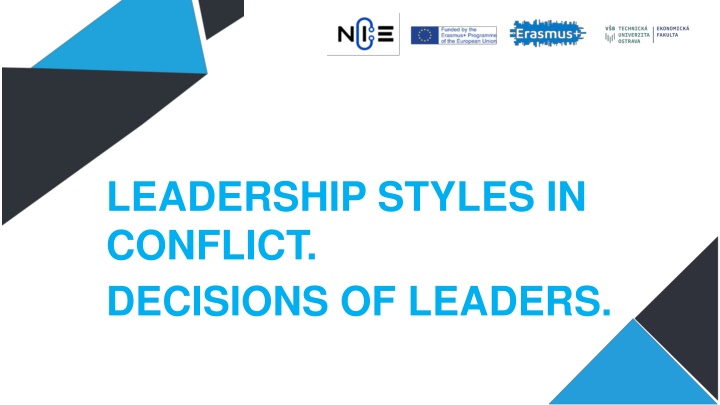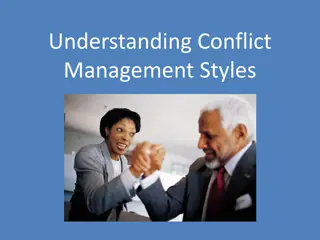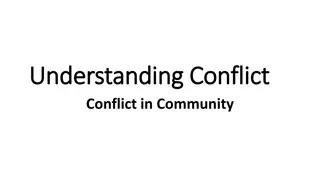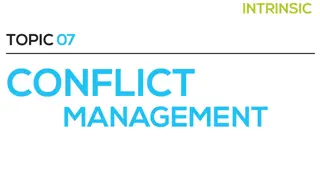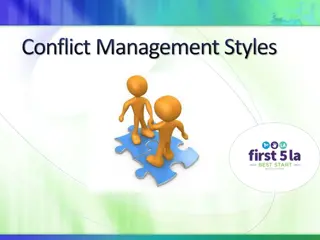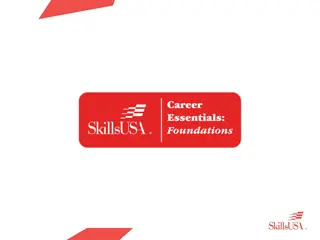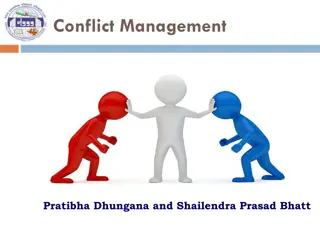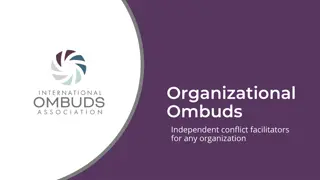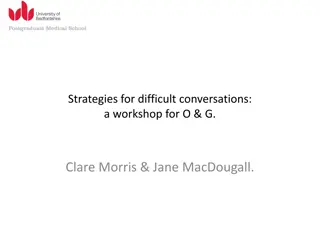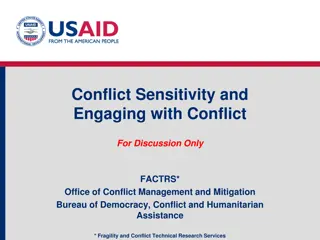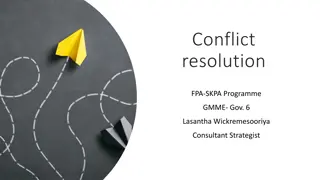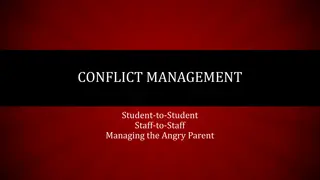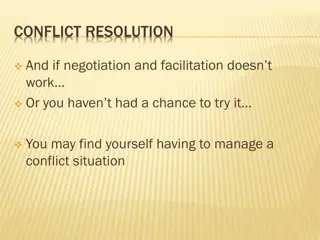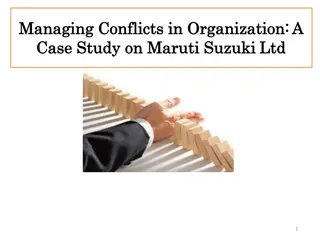Conflict Management Strategies in Organizations
Conflict in organizations is common but often avoided due to its negative impact. Effective conflict management is crucial for organizational success. Litigation can be detrimental to companies, leading to loss of control, prolonged disputes, and increased costs. Alternative Dispute Resolution (ADR) methods like mediation and arbitration offer benefits such as cost-effectiveness and voluntary participation. Building trust through conflict resolution processes can enhance relationships and reduce transaction costs.
Download Presentation

Please find below an Image/Link to download the presentation.
The content on the website is provided AS IS for your information and personal use only. It may not be sold, licensed, or shared on other websites without obtaining consent from the author.If you encounter any issues during the download, it is possible that the publisher has removed the file from their server.
You are allowed to download the files provided on this website for personal or commercial use, subject to the condition that they are used lawfully. All files are the property of their respective owners.
The content on the website is provided AS IS for your information and personal use only. It may not be sold, licensed, or shared on other websites without obtaining consent from the author.
E N D
Presentation Transcript
LEADERSHIP STYLES IN CONFLICT. DECISIONS OF LEADERS.
Conflict in organizations is often avoided and suppressed because of its negative consequences and to seek to preserve consistency, stability and harmony within the organization. (Nadler and Tushman, 1999)
For an organization to be successful, the employees are required to work in harmony to achieve its goals. (Saeed, 2014)
Why conflict? Conflict is everywhere Discourage litigation As a peace-maker the lawyer has a superior opportunity of being a good man. Abraham Lincoln, 1850 As peace-maker the mediator has a superior opportunity, too. And a superior responsibilty. What is the importance of conflict management? We can react several ways and on several levels https://www.youtube.com/watch?v=SorqWJUHbjM
Litigation present a series of inherent disadvantages for companies: 1. The parties may lose control, 2. The lawyers and the judicial system have power over the timing and procedure of the conflict resolution, 3. Disputes can take years to come to any resolution, 4. The parties lose the ability to communicate with each other in order to resolve the problem, 5. The costs of litigation increase significantly due to delays and (mostly) the lawyer s fees. The companies that become embroiled in litigation can lose its competitive advantage.
Alternative Dispute Resolution On the other hand: 1. ADRs have become progressively common due to the advantages such as benefits in costs , simplicity and maintenance of the power of the entire state of affairs , 2. A resolution is only reached if both sides accept to engage voluntarily in this process, 3. The dispute is mostly decided by the parties involved and less power is given to the third party involved (to the mediator).
Trust In acting as problem-solvers and looking to resolve the conflict, the parties develop a degree of trust in the conflict management process. This can be seen as an: agree to disagree approach to conflict. The development of trust between parties, even though they disagree on an issue, can be an asset and may help reduce transaction costs. This approach favours ADRs methods such as mediation or arbitration.
Mediation and arbitration are procedures based on interests and rights. The fact of taking commercial interests into account also means that the parties can decide the result in reference to their future relationship rather than solely by reference to his past conduct.
ORGANIZATIONAL ENVIRONMENT: Leaders make decisions leadership styles and conflict management styles Conflict management styles: individual disposition, stable over time and across situations. LEADERSHIP STYLES OR BEHAVIORS REMAIN STABLE over time and are expected to be significantly related to conflict management styles. TYPOLOGIES OF CONFLICT MANAGEMENT STYLES. (Blake and Mouton 1964, Thomas, 1976, Rahim and Bonoma., 1979)
TYPOLOGIES OF CONFLICT MANAGEMENT STYLES (1 - 3.) 1. INTEGRATING (collaborating) style: oppenness, exchange of information 2. OBLIGING (accomodating) style: is associated with attempting to play down the differences and emphasizing commonalities to stisfy the concerns of the other party. 3. DOMINATING (competing) style: people are more concerned with their own interest sthan their partner s interests.
TYPOLOGIES OF CONFLICT MANAGEMENT STYLES (4 - 6.) 4. AVOIDING style: associated with withdrawal or sidestepping situations based on having little or no concern for oneself or others. 5. COMPROMISING style: involves give and take, whereby both parties give up something to make a mutually acceptable decision. 6. TRANSFORMATIONAL leaders: rather than focusing solely on current needs of their employees or themseves focus on future needs.
TYPOLOGIES OF CONFLICT MANAGEMENT STYLES (7 - 8.) 7. TRANSACTIONAL leaders: identify and clarify subordinates job tasks and communicate to them how successful execution of tasks will lead to the receipt of desirable rewards. 8. LAISSEZ-FAIRE leaders: abdicate their responsiblity and avoid making decisions.
Practical Task 124 leaders were contacted and responded the questions. 1. In case of a conflict of your organization (inter- organizational conflict) which way of conflict resolution is preferred in your decision? AFTER I HAVE TRIED ALL NEGOTIATION WITH THE PARTIES I WILL:
Choose to start COURT procedure Choose ARBITRATION Choose MEDIATION Choose CONCILIATION
Choose MEDIATION Why do they choose Mediation? What do you think?
In case of a conflict of your organization (inter-organizational conflict) which way of conflict resolution is preferred in your decision? 4 7%Choose ARBITRATION 3 26% Start COURT procedure 1.Choose MEDIATION 48% 2 19% Choose CONCILIATION 1 2 3 4
Thank you for the cooperation. It is worth to settle.
